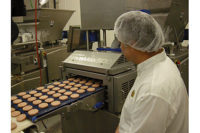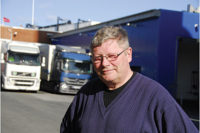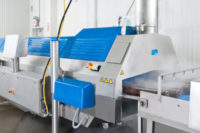Protein Problem Solver: First in U.S. meat industry
Interstate Meat switches blender chilling to liquid nitrogen -- a new option for bottom injection (BI).


|
| The bottom-injection chilling system on the 10,000-pounds-per-hour meat blender at Interstate Meat uses liquid nitrogen (LIN) and was optimized by Linde. Interstate realized significant “cost to chill” savings with the LIN BI system which cuts chill times by 50 percent. |
Interstate Meat Distributors Inc. (Clackamas, Ore.) processes more than 60 million pounds of ground beef and sausage a year, packaged in case ready trays, overwrap, fresh patties, IQF patties and chubs for distribution throughout the western U.S. Chilling during grinding/blending can dramatically impact throughput of forming operations, so the chilling system must be carefully matched for batch-to-batch repeatability.
Batch grinding/mixing operations also add thermal energy to the product. Most high-volume processors of ground meat and poultry have been chilling in mixing/blending vessels fitted with carbon dioxide (CO2), the only real choice for bottom-injection (BI) in the U.S. Interstate Meat president Darrin Hoy says Interstate first started using CO2 chilling in the mid-1980s.
While some processors still use CO2 snow horns or pellets, top-chilling methods are inherently less efficient. Top-chill snow horns may require 3X more time and 20-25% more cryogen to achieve the same desired temperature as BI systems.
New BI systems are normally installed with new mixing or forming equipment, though existing mixers even just a few years old can dramatically benefit from retrofits, which typically involve components such as nozzles and vent.
Interstate worked with Linde North America to beta test the ACCU-CHILL® liquid-nitrogen (LIN) BI system on one of the plant’s mixers -- in this case a 10K lbs/hr blender. Linde application engineers documented existing chilling process parameters, and designed a new hygienic nozzle injection system for multiple ports on the blending vessel, and a new exhaust system for the lid to make it a complete, matched system.
“One of the great attributes of the LIN bottom-injection system is you don’t have to mix the meat as long, and a shorter mix time is always better for your end product. You can grind more pounds per hour. There’s less emulsified fat because it’s not as beat up, so it looks better in the package, too,” says Hoy.
The optimized LIN BI system from Linde cut the chill time in the blender from eight minutes to three. It equilibrates batches to a target temperature with high batch-to-batch repeatability. Consistent chill temperatures also help keep forming equipment running smoothly and “smear free.”
“The Linde Food team worked closely with my management on implementation, often after hours to minimize downtime, right down to training all our employees on the new technology. The exhaust system eliminates clouding -- and from an environmental and hygienic perspective, everything is better than our CO2 system.”
Linde finalized the LIN BI system on the first mixer in January 2011, and the other production lines followed, with all lines now operating flawlessly for well over a year. The installation included new supply lines to the blenders, and a new LIN tank on a pad outside. (The new injection nozzles and venting system can run either CO2 gas or LIN.)
Linde supplies Interstate from its gas production facility in Vancouver, Washington, and reliable supply was an important part of the equation, Hoy says. Linde is the No. 1 supplier of CO2 gas in North America and a top supplier of N2 through its extensive distribution network. While cryogen costs vary by region, the production advantages of upgrading to an optimized BI system almost always pay off, and can tilt the scale in favor of LIN BI. For more information about optimizing bottom-injection chilling systems, visit Linde (www.lindefood.com) or call 800-755-9277.
Looking for a reprint of this article?
From high-res PDFs to custom plaques, order your copy today!







